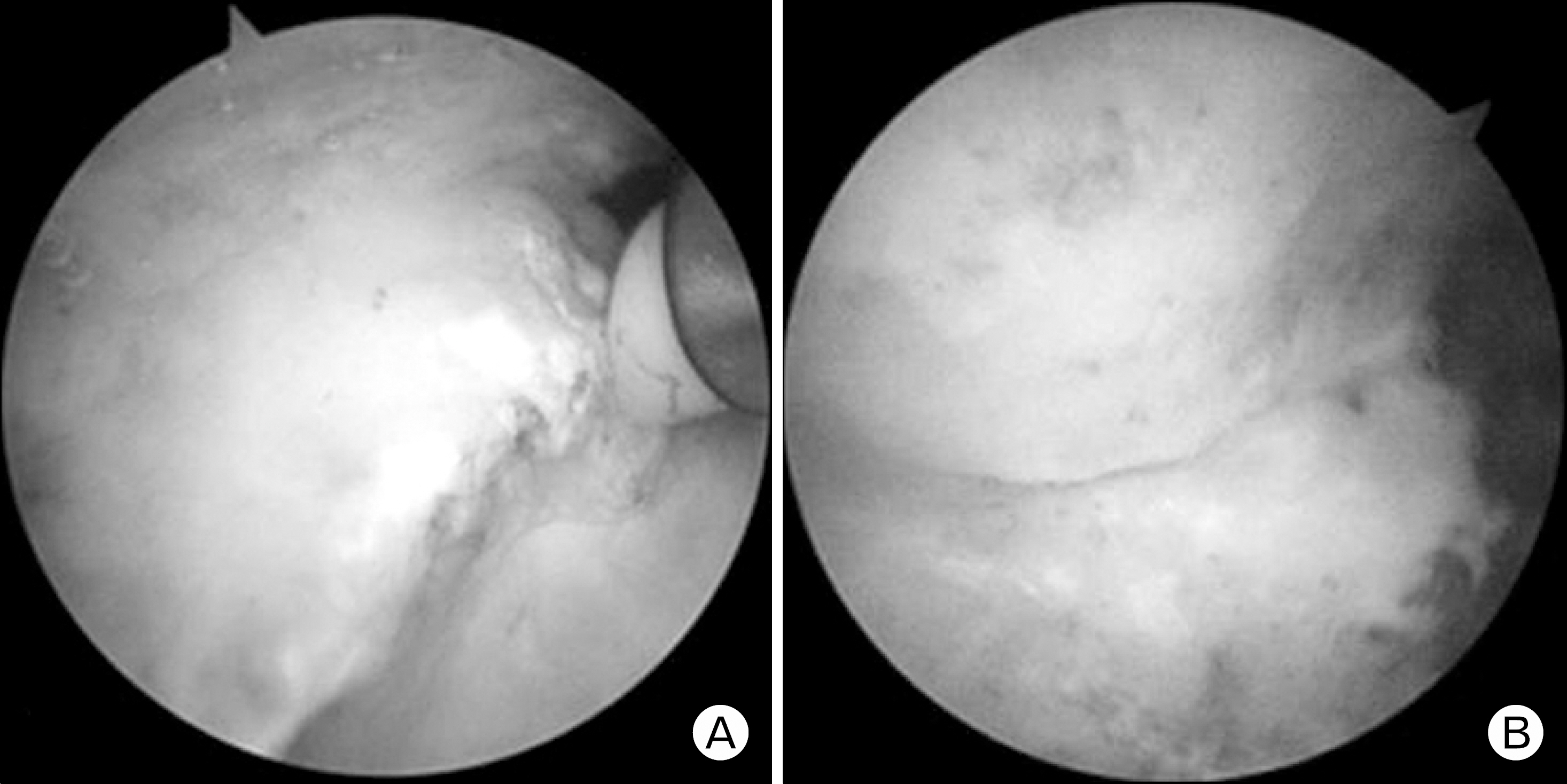Korean J Sports Med.
2013 Dec;31(2):45-50. 10.5763/kjsm.2013.31.2.45.
Arthroscopic Olecranon Osteophyte Resection in the Baseball Players with Elbow Valgus Extension Overload Syndrome
- Affiliations
-
- 1Glocal Center for Shoulder and Elbow, Department of Orthopedic Surgery, Konkuk University School of Medicine, Seoul, Korea.
- 2Department of Orthopaedic Surgery, Konkuk University Chungju Hospital, Konkuk University School of Medicine, Chungju, Korea. iulius00@naver.com
- KMID: 2288607
- DOI: http://doi.org/10.5763/kjsm.2013.31.2.45
Abstract
- We evaluated the clinical outcome after arthroscopic olecranon osteophyte resection without ligament operation in the elite baseball players who had valgus extension overload syndrome without moderate or severe medial collateral ligament injury. From January 2007 to December 2011, twelve patients underwent arthroscopic osteophyte resection without ligament operation and they were followed for more than 12 months. The mean age was 19.2 years and mean follow-up period was 26 months. The clinical results were evaluated using range of motion, visual analogue scale (VAS) and Mayo elbow performance score (MEPS). After checking osteophyte size and location through 3-dimensional computed tomography, arthroscopic osteophyte resection was performed. Average preoperative extension, flexion, pronation and supination were 2.3degrees, 138.2degrees, 76.4degrees, and 69.1degrees. Average postoperative extension, flexion, pronation and supination had been changed into 0.7degrees, 137.3degrees, 79.1degrees, and 77.3degrees. Average preoperative pain VAS and MEPS were 5.5 and 67.5. Average postoperative pain VAS and MEPS had been changed into 0.4 (p<0.001) and 97.5 (p<0.001). Eleven patients returned to play. Ten cases returned to their own position. No patients were performed other operation for elbow pain. The arthroscopic osteophyte resection in valgus extension overload syndrome with low grade medial ulnar collateral ligament (MUCL) injury or without MUCL injury was a one of the ideal treatment option for early return to pre-injury levels and relief of pain.
MeSH Terms
Figure
Reference
-
References
1. Bennett GE. Elbow and shoulder lesions of baseball players. Am J Surg. 1959; 98:484–92.
Article2. Ahmad CS, Conway JE. Elbow arthroscopy: valgus extension overload. Instr Course Lect. 2011; 60:191–7.3. Dugas JR. Valgus extension overload: diagnosis and treatment. Clin Sports Med. 2010; 29:645–54.
Article4. Andrews JR, Timmerman LA. Outcome of elbow surgery in professional baseball players. Am J Sports Med. 1995; 23:407–13.
Article5. Wilson FD, Andrews JR, Blackburn TA, McCluskey G. Valgus extension overload in the pitching elbow. Am J Sports Med. 1983; 11:83–8.
Article6. Tullos HS, King JW. Throwing mechanism in sports. Orthop Clin North Am. 1973; 4:709–20.
Article7. Slocum DB. Classification of elbow injuries from baseball pitching. Tex Med. 1968; 64:48–53.8. Chen FS, Rokito AS, Jobe FW. Medial elbow problems in the overhead-throwing athlete. J Am Acad Orthop Surg. 2001; 9:99–113.
Article9. Aguinaldo AL, Chambers H. Correlation of throwing mechanics with elbow valgus load in adult baseball pitchers. Am J Sports Med. 2009; 37:2043–8.
Article10. Reddy AS, Kvitne RS, Yocum LA, Elattrache NS, Glousman RE, Jobe FW. Arthroscopy of the elbow: a longterm clinical review. Arthroscopy. 2000; 16:588–94.
Article11. Kamineni S, ElAttrache NS, O'Driscoll SW, et al. Medial collateral ligament strain with partial posteromedial olecranon resection: a biomechanical study. J Bone Joint Surg Am. 2004; 86:2424–30.
Article12. Ahmad CS, Park MC, Elattrache NS. Elbow medial ulnar collateral ligament insufficiency alters posteromedial olecranon contact. Am J Sports Med. 2004; 32:1607–12.
Article13. Kamineni S, Hirahara H, Pomianowski S, et al. Partial posteromedial olecranon resection: a kinematic study. J Bone Joint Surg Am. 2003; 85:1005–11.14. Andrews JR, Heggland EJ, Fleisig GS, Zheng N. Relationship of ulnar collateral ligament strain to amount of medial olecranon osteotomy. Am J Sports Med. 2001; 29:716–21.
Article15. An KN, Morrey BF, Chao EY. The effect of partial removal of proximal ulna on elbow constraint. Clin Orthop Relat Res. 1986; 209:270–9.
Article16. Morrey BF, An KN. Functional anatomy of the ligaments of the elbow. Clin Orthop Relat Res. 1985; 201:84–90.
Article17. Andrews JR. Bony injuries about the elbow in the throwing athlete. Instr Course Lect. 1985; 34:323–31.18. Morrey BF, An KN. Articular and ligamentous contributions to the stability of the elbow joint. Am J Sports Med. 1983; 11:315–9.
Article19. Azar FM, Andrews JR, Wilk KE, Groh D. Operative treatment of ulnar collateral ligament injuries of the elbow in athletes. Am J Sports Med. 2000; 28:16–23.
Article20. Conway JE, Jobe FW, Glousman RE, Pink M. Medial instability of the elbow in throwing athletes. Treatment by repair or reconstruction of the ulnar collateral ligament. J Bone Joint Surg Am. 1992; 74:67–83.
Article21. Thompson WH, Jobe FW, Yocum LA, Pink MM. Ulnar collateral ligament reconstruction in athletes: muscle-splitting approach without transposition of the ulnar nerve. J Shoulder Elbow Surg. 2001; 10:152–7.
Article22. Bennett GE. Shoulder and elbow lesions distinctive of baseball players. Clin Orthop Relat Res. 2012; 470:1531–3.
Article
- Full Text Links
- Actions
-
Cited
- CITED
-
- Close
- Share
- Similar articles
-
- Hyperextension Overload Syndrome of the Elbow in Baseball Pichers
- Elbow Impingement Syndrome in Athletes
- Separation of Unfused Olecranon Epiphysis in an Adult Baseball Pitcher: A Case Report
- Arthroscopic Treatment of Stiff Elbow
- Gravity Valgus Stress Ultrasonographic Assessment of Ulnar Collateral Ligament Injury among Baseball Players



